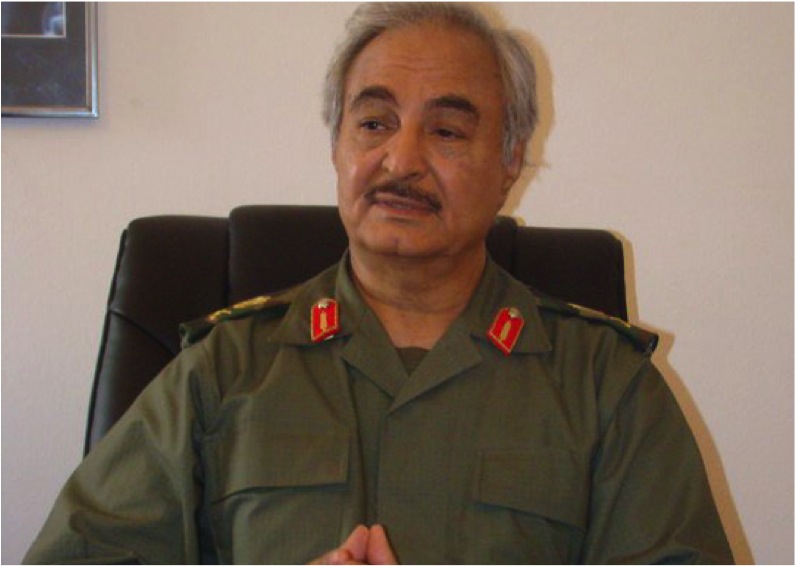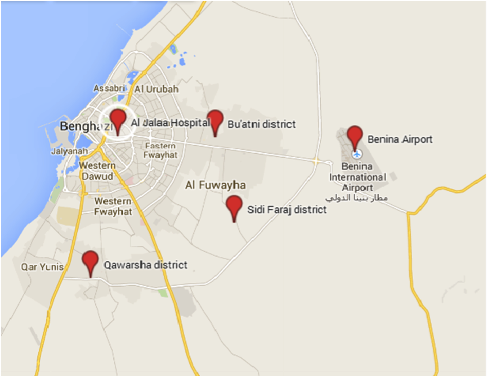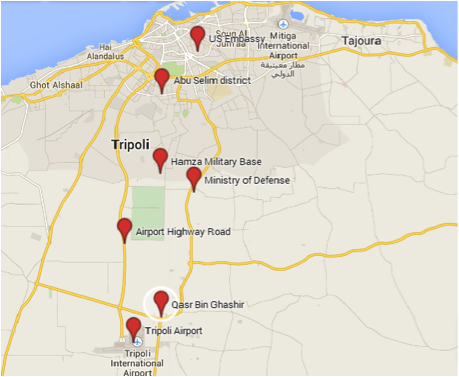Libya’s Islamist Counteroffensive

Through much of June and the first half of July, fighting between the forces of rogue General Khalifa Hifter and Benghazi’s Islamist militias had reached an uneasy stalemate that now appears to be broken. Hifter began a military push on May 16, promising to “cleanse” Benghazi of its Islamist militias. Though the two sides soon found themselves deadlocked, with neither making real gains, Islamist militias have now initiated a counteroffensive that has succeeded in seizing key Hifter and Hifter-allied bases, including the critical Libyan special forces Bu’atni district base. (The Libyan special forces are part of Libya’s regular military, and have aligned themselves with Hifter but “have not placed themselves under his command.”)
The Islamist counteroffensive marks the first time these militias have succeeded in gaining ground and dictating the operational tempo of the fighting. Moreover, following the seizure of the Bu’atni district base, a spokesman for Ansar al-Sharia in Libya (ASL), one of the major anti-Hifter factions, reportedly announced that the group had established an “Islamic emirate” in Benghazi. Though Hifter quickly rejected ASL’s declaration, and said that his forces were planning future offensives following their tactical retreat, the boldness of ASL’s claims suggest the group believes it has weathered the worst of the storm. One factor that both enabled ASL’s recent gains and is also bolstering its confidence is the return of Libyan jihadists from Syria and Iraq.
But despite the reinforcements, the Islamist groups face continuing challenges. Their militias don’t have Hifter decisively outgunned and his forces retain exclusive control of the air over Benghazi. The Islamist militias also confront increasing discontent from the population of Benghazi, which has become disgruntled with the growing extremism of some Islamist factions—as evidenced by angry protests that erupted following the declaration of an Islamic emirate.
Another major military movement is occurring simultaneously in Tripoli, the Libyan capital. Militias operating there, many of whom are headquartered in the coastal city of Misrata, launched an offensive known as “Operation Dawn” to wrest control of the Tripoli airport from Zintan-based militias that have held it since dictator Muammar Qaddafi fell in 2011. The spread of violence to previously tranquil areas of the city has forced several Western countries, including the United States and Britain, to close their embassies and evacuate their diplomats.
The fighting in Tripoli has broken down along religious and political lines that mirror those in Benghazi. The Misratan militias, led by former MP Salah Badi, have cooperated with the Islamist-leaning Libya Revolutionaries’ Operations Room militia in Tripoli, and are aligned with Islamist political factions in parliament. On July 30, Mohammed Sawan, the leader of the Libyan Muslim Brotherhood’s political wing, endorsed the Misratan militias’ campaign, calling it a “legitimate” response to Hifter’s Benghazi offensive. Conversely, the Zintan-based Qa’qaa’ and Sawa’iq (Thunder and Lightning) militias, which operate in Tripoli, have endorsed Hifter’s offensive, and even participated in the dramatic May 18 operation that seized control of the national parliament building.
While the Islamist counteroffensive in Benghazi is a tactical response to Hifter’s campaign in the city, analysts have linked developments in Tripoli to the political conflict between Islamist and liberal blocs in parliament. Since Libya’s elections in July 2012, the General National Congress has been increasingly dominated by Islamist political parties, such as the Brotherhood-aligned Justice and Construction Party. Yet political support for Islamists has waned: this year’s elections on June 25 were expected to dilute the Islamist parties’ power (but the net impact on Islamists’ power remains unclear due to the country’s current instability). Some observers believe Islamist militias launched Operation Dawn in advance of the new parliament convening in order to change facts on the ground and expand Islamist power in the capital before the liberal bloc could take more power.
This article, like our July 15 War on the Rocks article on Hifter’s stalled campaign, now examines key strategic locations in both the Benghazi counteroffensive and the Tripoli fighting. Our research method has been to monitor tactical movements day by day, drawing from all available regional and international sources, including both English and Arabic-language accounts.
Key Strategic Locations in Benghazi
The primary focus of the Islamist counteroffensive has been the military base in Bu’atni district, which is the home of the Sa’iqa (Lightning) special forces unit led by Col. Wanis Bukhamada. Islamist militias, including the Rafallah al-Sahati Brigade and the February 17 Brigade, began shelling the Bu’atni base on July 19, and mounted a ground assault on July 21. Islamist militias followed the initial offensive with a double vehicular suicide bombing against the base on July 22 that killed at least four.
Following the suicide bombings and continued ground attacks, Col. Bukhamada announced a state of alert, calling on special forces units across eastern Libya to provide reinforcements. Despite this, by July 24, Islamist militias who fought under the banner of the Benghazi Rebel Shura Council announced that they had taken over other special forces bases in Benghazi. On July 29 Bukhamada confirmed that his unit had withdrawn from Bu’atni.
Hifter’s forces were quick to respond. On July 30, they reportedlyregained control of Benghazi’s Security Directorate, and a day later additional reports claimed that Hifter had taken back of one of the other Special Forces bases.
While Hifter hopes these gains will swing momentum back toward him, his forces have been rebuffed as they tried to make other territorial gains. On July 25, they proved unable to move ground forces into Sidi Faraj,a neighborhood abutting Hifter’s stronghold in the Benina airport. Islamists continue to use Sidi Faraj to launch rocket strikes into Benina. Hifter’s forces previously attempted to move into Sidi Faraj on June 15, but were similarly repelled.
The Al-Jalaa Hospitalhas also been a central focus of operations for Hifter, who on July 15 declared the commencement of a “battle to liberate Al-Jalaa” from ASL, which has used the hospital to treat its fighters. Hifter launched ground operations and air strikes against ASL positions, and reportedly forced ASL fighters to retreat from the hospital to an adjacent school building. Though ASL regained control of Al-Jalaa soon after Hifter captured it, the group was forced to evacuate again on July 30, when several hundred demonstrators stormed into the hospital. The demonstrators, who replaced ASL’s black banner with a Libyan flag, were reportedly inflamed by ASL’s declaration of an Islamic emirate. (ASL’s emirate, assuming the announcement is genuine, may prove short-lived: the Libyan Muslim Brotherhood won’t endorse it, and the announcement may be too hasty for regional jihadists to back.)
Fighting also continues to rage in Qawarsha district in southwestern Benghazi, where Islamist militias have a strong presence.
Key Strategic Locations in Tripoli
Fighting in Tripoli has been concentrated in the southern, western and central parts of the city, as the Misratan militias try to establish control over key supply lines and attempt also to drive Zintani militias out of their areas of operation. The Tripoli International Airporthas been the Misratan groups’ focus, and since they initiated their campaign to capture the airport, clashes in the city have left over 230 people dead. The Misratan groups have maintained a steady barrage of rocket strikes against the facility. Just two days after their bombardment commenced, the Libyan government estimated that 90% of the planes at the airport had been destroyed, and rockets “damaged the airport’s control tower.” Rockets also hit the main fuel depot close to the airport, igniting massive fires.
Misratan militias have also tried to seize key neighborhoods surrounding the airport in order to isolate the Zintani groups. Fierce fighting has raged in Qasr bin Ghashir, which is adjacent to the airport, while both sides battle for control of the Airport Highway Road. On July 25, Islamist militias reportedly seized the Hamza military basenorth of Qasr bin Ghashir, which had previously been under the control of Zintani militias.
Though the fighting in Tripoli has centered around the airport, clashes have also broken out in central Tripoli. Zintani militias launched a counteroffensive July 18 in Abu Selim, a district dominated by Islamist militias that is relatively close to the U.S. embassy.
Next Steps in the Conflict
Though the Islamist counteroffensive in Benghazi has set back Hifter’s forces, his coalition may be able to exact revenge. Hifter’s fighters remain entrenched in bases surrounding Benghazi and continue to employ airpower against Islamist targets. But it remains to be seen whether his forces can regain their momentum, especially after the influx of fighters to the other side. Meanwhile, the outcome of the country’s political transition will influence the future of the conflict in Tripoli. But even a détente between Islamist and liberal parties won’t be sufficient to bring long-term stability to either Tripoli or Libya.
The real policy question that the U.S. confronts in Libya is whether it should throw its support behind Hifter, either overtly or covertly. As our last War on the Rocks article about Hifter’s campaign notes, one reason Western countries have hesitated is because of questions surrounding Hifter and what his empowerment would mean for Libya’s future. While these questions remain, Hifter’s foes have over time appeared more dangerous to some observers, and certainly Libya’s neighbors see a growing threat to their interests. Thus, we may increasingly hear calls for outside states to support Hifter—if it isn’t already too late to do so—and they are worth seriously considering.
For now, the U.S. and other Western countries face heightened dangers. The closing of the U.S. embassy was a wise precautionary move. But though the U.S. can remove its diplomats, it will continue to have strategic interests in the region—and the bleeding caused by Libya’s security meltdown will pose an ongoing threat to these interests.
Daveed Gartenstein-Ross is a senior fellow at the Foundation for Defense of Democracies (FDD) and an adjunct professor in Georgetown University’s security studies program. Oren Adaki is an Arabic language specialist and research associate at FDD specializing in the Arab world. Nathaniel Barr is a research intern at FDD.
Photo credit: Magharebia



